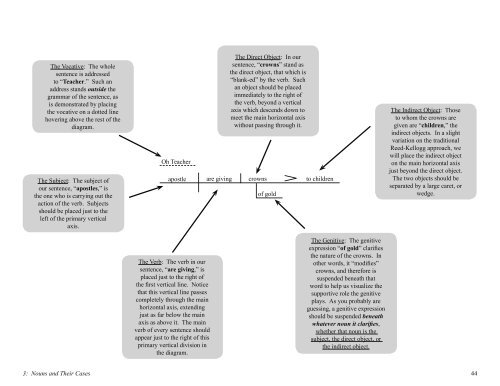Elementary New Testament Greek, 2014a
Elementary New Testament Greek, 2014a
Elementary New Testament Greek, 2014a
You also want an ePaper? Increase the reach of your titles
YUMPU automatically turns print PDFs into web optimized ePapers that Google loves.
The Vocative: The whole<br />
sentence is addressed<br />
to “Teacher.” Such an<br />
address stands outside the<br />
grammar of the sentence, as<br />
is demonstrated by placing<br />
the vocative on a dotted line<br />
hovering above the rest of the<br />
diagram.<br />
The Subject: The subject of<br />
our sentence, “apostles,” is<br />
the one who is carrying out the<br />
action of the verb. Subjects<br />
should be placed just to the<br />
left of the primary vertical<br />
axis.<br />
Oh Teacher<br />
The Direct Object: In our<br />
sentence, “crowns” stand as<br />
the direct object, that which is<br />
“blank-ed” by the verb. Such<br />
an object should be placed<br />
immediately to the right of<br />
the verb, beyond a vertical<br />
axis which descends down to<br />
meet the main horizontal axis<br />
without passing through it.<br />
apostle are giving crowns to children<br />
of gold<br />
The Indirect Object: Those<br />
to whom the crowns are<br />
given are “children,” the<br />
indirect objects. In a slight<br />
variation on the traditional<br />
Reed-Kellogg approach, we<br />
will place the indirect object<br />
on the main horizontal axis<br />
just beyond the direct object.<br />
The two objects should be<br />
separated by a large caret, or<br />
wedge.<br />
The Verb: The verb in our<br />
sentence, “are giving,” is<br />
placed just to the right of<br />
the rst vertical line. Notice<br />
that this vertical line passes<br />
completely through the main<br />
horizontal axis, extending<br />
just as far below the main<br />
axis as above it. The main<br />
verb of every sentence should<br />
appear just to the right of this<br />
primary vertical division in<br />
the diagram.<br />
The Genitive: The genitive<br />
expression “of gold” claries<br />
the nature of the crowns. In<br />
other words, it “modies”<br />
crowns, and therefore is<br />
suspended beneath that<br />
word to help us visualize the<br />
supportive role the genitive<br />
plays. As you probably are<br />
guessing, a genitive expression<br />
should be suspended beneath<br />
whatever noun it claries,<br />
whether that noun is the<br />
subject, the direct object, or<br />
the indirect object.<br />
3: Nouns and Their Cases<br />
44


















